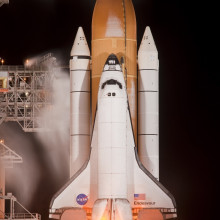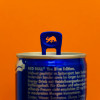NASA's David Blake from the Mars Science Laboratory (MSL) Curiosity rover team and the Open University's Cassini-Huygens space probe pioneer John Zarnecki answer your questions about planetary exploration. This special podcast is an addendum to the August 5th 2012 episode of the Naked Scientists Podcast and contains extra material not included in the published programme.
In this episode
How do Rovers Cope with Low Temperatures?
David - Very good question. First of all, the nuclear power source on the back of the rover produces a bit over 100 watts of electrical energy, but it also produces 900 watts of thermal energy. And they actually have a fluid loop that takes the heat from the radioactive and runs it across what they call 'rover avionics mounting platform' where all the instruments are connected. And so, that keeps us inside the rover in kind of a shirtsleeves environment. Now, the instruments outside the rover do have to contend with this very bitter cold temperatures during the nights.
Chris - John, what about your experience on Titan that's minus 180 whatever it is, degrees C?
John - Yes. I mean, you think Mars is tough but Titan is a lot colder, I think. Thermal design for spacecraft is very often one of the most challenging parts of the whole business. In the case of the Huygens probe, as I guess is true with Curiosity, you've got two extremes. You've got the extreme heat generated by the high speed entry into a planetary atmosphere and then once you've landed on the surface, you've got extreme cold. So it's really all about, I would say, good design, good thermal design and generally conserving the little heat that you generate within the probe. You have to go to what to me, as a scientist, seems like ridiculous lengths. You even worry about the tiny amount of heat that is conducted down a very, very thin electrical cable and you have to use special electrical cable which is a good electrical conductor but a poor thermal conductor so, attention to detail at the minutest level.
How Much do Space Missions Cost?
First, we asked Professor John Zarnecki about the Cassini-Huygens mission...
John - Well, it was a snip to be honest. I think Cassini-Huygens, the whole thing - I'm talking round numbers here - was about 4.5 billion euros or dollars, which are about the same, of which a quarter or 20% was spent in Europe. Now, you've got to remember that was over probably 15 years, spread out amongst - if you add all of the citizens of the US and Europe, that's around 700 million people. It works out at something like a couple of cups of coffee per person per year and remember that money is not spent on Mars or on Saturn. It's spent on Earth, and it's spent mostly in high-tech industry paying people and paying industry to develop technology. So I think it's money well-spent. In the grand scheme of things, it's not a vast amount of money.
Chris - Same question to you David, how much is the Mars Science Laboratory costing?
David - I guess end to end, about $2.4 billion, or the equivalent in euros. Same answer, kind of, this was spent over about 10 years over 7,000 scientists and engineers. We get the same kind of results. I think in the US they make a comparison that people spend more money on bubble gum than they do on NASA. And people spend more money on beer advertising than they spend on NASA. So, even though it sounds like a huge sum of money, divided by the total amount over the population, it's really not very much compared to other things, and we really get great benefit out of it.
Will Curiosity Have the Longevity of Voyager I?
David - Well, we sure hope so. I think I'll be well-retired by then, but it is nuclear powered so we won't have the problem of solar panels getting covered with dust. I guess really the only issue we're going to have is that same nuclear power that keeps us going is also going to be firing off neutrons at us at a rapid rate. And those neutrons can cause damage over time so, we're kind of in a race to get as much information as we can and if we last 10 years, well we'll still be sending information back.

How do Astronomers Know Where Planets Are?
Dominic - We know the laws of gravity that the planets are orbiting under and we can see how long it takes those planets to orbit around the Sun. There's actually a very simple numerical relationship according to Newton's Law of Gravity as to how long a planet should take to circle the Sun as a function of how far away from the Sun it is. And so, that's how we've historically made estimates of how far away the planets are. In fact, in the last 20 years or so, we started firing radar at Venus and Mars, which are the nearest planets to us, and we can time how long it takes the radar pulses to come back. And that tells us within a matter of hundreds of metres where those planets are.
Why Have Planets Got Most of the Solar System's Angular Momentum?
Dominic - I think that's actually one of the real puzzles of our solar system, why the mass is all in the Sun, but the angular momentum is all in the planets that orbit around it. John.
John - Yes, I mean something must have happened to bring that about because as you said earlier, the Sun and the planets formed out of one rotating disk of materials. So something has happened to give us this situation where the angular momentum is in the planets rather than the Sun. So, theorists come up with all sorts of great theories involving viscosity and friction and so on to explain it away, but it's a perceptive question.

Why do Ships Lose Contact When They're Entering the Atmosphere?
If you have a high speed entry, you create a pocket of ionised gas around your probe. The gas is heated up so much, it becomes ionised - it's stripped of its electrons. That is not transparent to radio waves, so you have a radio black out. The same thing happens with vehicles re-entering the Earth's atmosphere. It used to happen with the shuttle I think and the Apollo vehicles. So that's the main reason. It's the state of the gas around a high speed probe.










Comments
Add a comment